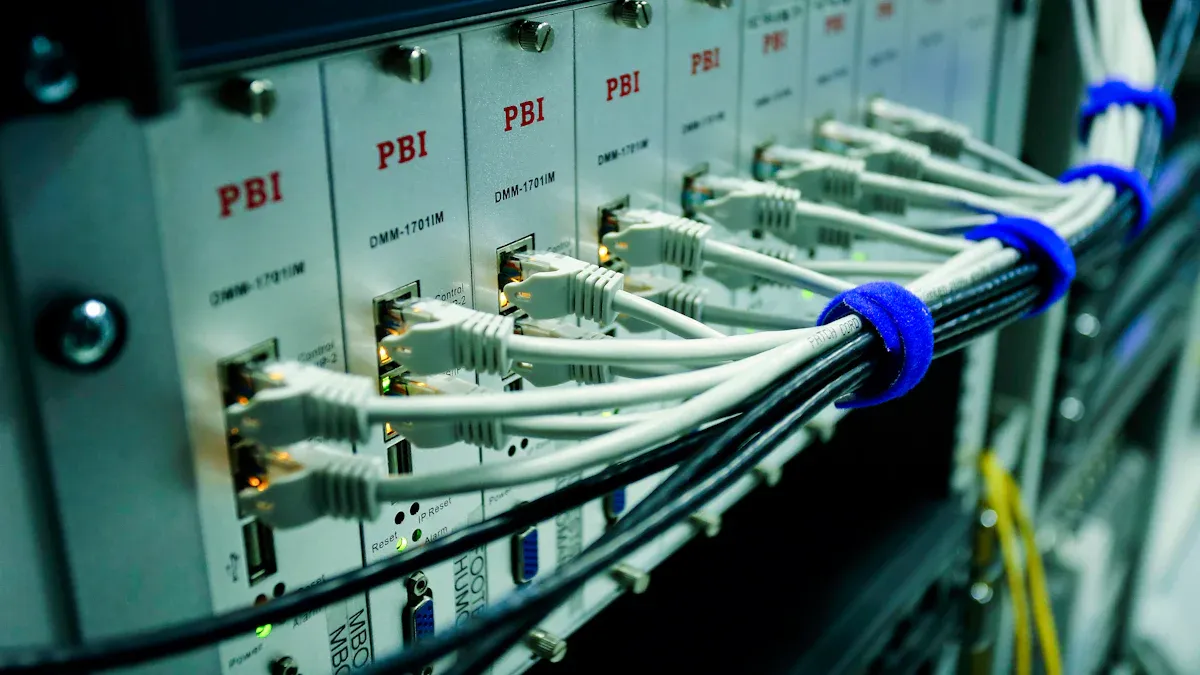
A fiber optic splitter distributes optical signals from a single source to many users. This device supports point-to-multipoint connections in FTTH networks. The fiber optic splitter 1×2, fiber optic splitter 1×8, multimode fiber optic splitter, and plc fiber optic splitter all provide reliable, passive signal delivery.
Key Takeaways
- Fiber optic splitters share one high-speed internet signal with many users, making networks efficient and reliable.
- Using splitters lowers costs by reducing cables, installation time, and power needs, simplifying network setup and maintenance.
- Splitters allow easy network growth by adding more users without major changes, supporting both small and large deployments.
Fiber Optic Splitter Fundamentals
What Is a Fiber Optic Splitter?
A fiber optic splitter is a passive device that divides a single optical signal into multiple signals. Network engineers use this device to connect one input fiber to several output fibers. This process allows many homes or businesses to share the same high-speed internet connection. The fiber optic splitter does not require power to operate. It works well in both indoor and outdoor environments.
How Fiber Optic Splitters Work
The fiber optic splitter uses a special material to split light signals. When light enters the device, it travels through the splitter and exits through several output fibers. Each output receives a portion of the original signal. This process ensures that every user gets a reliable connection. The splitter maintains signal quality, even as it divides the light.
Note: The efficiency of a fiber optic splitter depends on its design and the number of outputs.
Types of Fiber Optic Splitters
Network designers can choose from several types of fiber optic splitters. The two main types are Fused Biconical Taper (FBT) splitters and Planar Lightwave Circuit (PLC) splitters. FBT splitters use fused fibers to split the signal. PLC splitters use a chip to divide the light. The table below compares these two types:
| Type | Technology | Typical Use |
|---|---|---|
| FBT | Fused fibers | Small split ratios |
| PLC | Chip-based | Large split ratios |
Each type offers unique benefits for different FTTH network needs.
Fiber Optic Splitter Roles and Benefits in FTTH Networks

Efficient Signal Distribution
A fiber optic splitter enables a single optical signal to reach many users. This device divides the light from one fiber into several outputs. Each output delivers a stable and high-quality signal. Service providers can connect multiple homes or businesses without installing separate fibers for each location. This approach ensures efficient use of network resources.
Tip: Efficient signal distribution reduces the need for extra cables and equipment, making network management easier.
Cost Savings and Simplified Infrastructure
Network operators often choose a fiber optic splitter to lower costs. By sharing one fiber among many users, companies save on both material and labor expenses. Fewer cables mean less digging and less time spent on installation. Maintenance becomes simpler because the network has fewer points of failure. The passive nature of the splitter also eliminates the need for electrical power, which further reduces operational costs.
Key cost-saving benefits include:
- Lower installation expenses
- Reduced maintenance needs
- No power requirements
Scalability and Flexibility for Network Growth
Fiber optic splitters support network growth with ease. Providers can add new users by connecting more output fibers to the splitter. This flexibility allows networks to expand as demand increases. The modular design of splitters fits both small and large deployments. Service providers can upgrade or reconfigure the network without major changes to the existing infrastructure.
Technical Features for Modern Deployments
Modern fiber optic splitters offer advanced features that meet today’s network demands. These devices maintain signal quality even when splitting the light into many outputs. They resist environmental changes such as temperature and humidity. Splitters come in different sizes and configurations, including rack-mounted and outdoor models. This variety allows engineers to select the best option for each project.
| Feature | Benefit |
|---|---|
| Passive operation | No external power needed |
| Compact design | Easy installation |
| High reliability | Consistent performance |
| Wide compatibility | Works with many network types |
Real-World FTTH Application Scenarios
Many cities and towns use fiber optic splitters in their FTTH networks. For example, a service provider may install a 1×8 splitter in a neighborhood. This device connects one central office fiber to eight homes. In apartment buildings, splitters distribute internet to each unit from a single main line. Rural areas also benefit, as splitters help reach distant homes without extra cables.
Note: Fiber optic splitters play a key role in delivering fast and reliable internet to both urban and rural communities.
A fiber optic splitter helps deliver fast, reliable internet to many homes. Network providers trust this device for its efficiency and cost savings. As more people need high-speed connections, this technology remains a key part of modern FTTH networks.
Reliable networks depend on smart solutions like fiber optic splitters.
FAQ
What is the typical lifespan of a fiber optic splitter?
Most fiber optic splitters last over 20 years. They use durable materials and require little maintenance in both indoor and outdoor environments.
Can fiber optic splitters affect internet speed?
A splitter divides the signal among users. Each user receives a portion of the bandwidth. Proper network design ensures everyone gets fast, reliable internet.
Are fiber optic splitters difficult to install?
Technicians find splitters easy to install. Most models use simple plug-and-play connections. No special tools or power sources are needed.
By: Eric
Tel: +86 574 27877377
Mb: +86 13857874858
E-mail: henry@cn-ftth.com
Youtube: DOWELL
Pinterest: DOWELL
Facebook: DOWELL
Linkedin: DOWELL
Post time: Jul-20-2025
